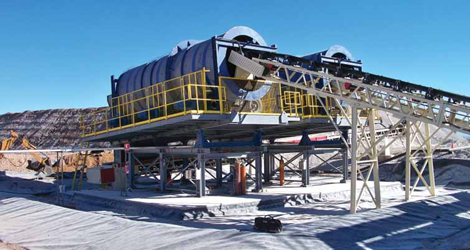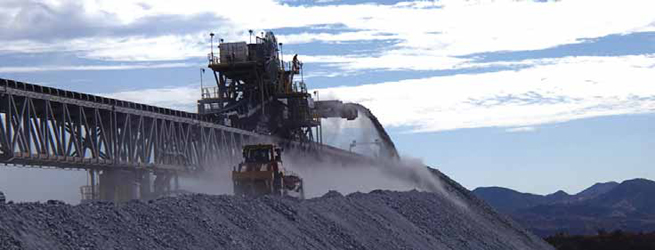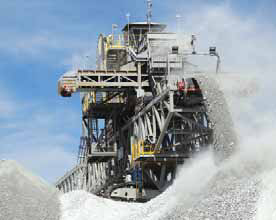 Kinross Gold’s Ft. Knox gold mine in Alaska produces about 40% of its annual output from the Walter Creek valley fill heap leach
Kinross Gold’s Ft. Knox gold mine in Alaska produces about 40% of its annual output from the Walter Creek valley fill heap leach
operation, pictured here. At full development,
maximum heap height from toe to crest will be approximately 1,100 ft and maximum ore
thickness in the pad about 500 ft. Construction began in 2007 with the project
scheduled to be built in seven stages extending to 2021.
(Photo: Knight Piésold)
Heap leaching is typical of most mineral
extraction methods in that it is easy to
grasp in concept and difficult to perfect
in practice. At first glance, percolating a
solution through a pile of crushed rock to
capture metal values sounds like the easiest
possible way to recover gold, copper
and other amenable metals, surpassed in
simplicity only by in situ mining.
However, in the same vein as the military
maxim that “the enemy always gets
a vote” in a battle’s outcome, a number
of complicating factors often have votes in
the outcome of a heap leaching campaign.
These include local weather conditions,
ore composition variability, leach pad
design and maintenance, and the hardto-
figure settlement and segregation behavior
of rock fragments and particles, to
name just a few. Regulatory and societal
concerns involving the use of cyanide or
sulphuric acid in large quantities as well
as the potential for environmental damage
by fluid leakage from pad linings or piping
can also affect the operational ‘ballot.’
Yet, these risk factors generally don’t
deter companies from planning and developing
heap-leach operations where the
mineralogy, topography and applicable
technology are appropriate. Heap leaching
often offers smaller or less-capitalized
companies an affordable, relatively
quick path to production. For companies
that own an oxide ore-capped sulphide
deposit, heap leaching of the oxides
can generate revenue needed to buy and
build the facilities needed to later process
the sulphide ore.
Partly because of its relative economy
of capital and quick startup capabilities,
heap leaching technology is successfully
being adapted to cope with increasingly
riskier environments such as extended
frigid weather conditions, enabling
leach operations to function effectively
in high-altitude locales or in Arctic or
sub-Arctic regions. In a paper presented
at the Heap Leach Solutions 2015 conference
held in Reno, Nevada, USA, authors
Krishna P. Sinha and Mark E. Smith noted
that there are a surprisingly large number
(>70) of cold-climate heap leach projects
either being planned or currently operating
at production rates ranging from less
than 1 million mt/y to 30 million mt/y.
Although cold-climate heap leach
mines face operational challenges, they can be as equally attractive as their
moderate-climate counterparts for, say,
larger producers in need of additional
production from proven reserves. A case
in point is Kaminak Gold Corp., former
owner of the Coffee gold project in
Canada’s Yukon province: Kaminak was
acquired by Goldcorp for $520 million
in 2016 after a feasibility study for the
Coffee project indicated that the mine,
which would employ heap leaching,
could be paid for in just two years with
initial production of more than 200,000
oz/y over the first five years at an estimated
AISC of $550/oz.
The Coffee project would be part of a
trio of cold-climate mines and advanced
projects in the Yukon/northern Alaska
region of North America; At latitude
65° north, Kinross’ long-running Fort
Knox gold mine in Alaska is currently
the northernmost heap-leach operation
in North America, producing 40% of its
total annual production of 390,000 oz
of gold from the year-round Walter Creek
heap-leach facility. Fort Knox poured its
seven-millionth ounce of gold in 2016.
And, Victoria Gold is advancing the Eagle
Gold project in the Yukon, developing
a deposit containing an estimated 2.66
million oz in reserves at 0.7 g/t. Eagle’s
AISC are anticipated to be less than
$700 per oz, with an annual production
rate of 200,000 oz.
As the authors of the conference paper
point out, cold-climate operations require
unique design and operational considerations,
including possibly seasonal operations,
maintaining heat within or adding
heat to the heap, permafrost management,
leaching kinetics (especially for
bioleach operations), managing ice and
snow, and closure.
But leach operators in more moderate
climatic locales usually can’t function in
a set-it-and-forget-it mode, either: producers
both large and small continually
tweak the parameters of their existing
leach setups to overcome problems arising
from changes in external or pad-internal
conditions; these countermeasures,
for example, range from crushed-ore
agglomeration, or applying liner ‘raincoats’
to exclude excess moisture from
heavy precipitation, to drilling injection
wells directly into the heap to improve
leach-solution access, and even to exploring
new methods to process ripios, or
spent ore, for further metal extraction.
Kinross Gold’s Bald Mountain openpit
heap-leach mine in eastern Nevada
and its Round Mountain mine in the
south-central part of the state provide
good examples of typical modifications
to improve leaching efficiency and overall
performance: During a 2016 tour
of Bald Mountain — one of the largest
mine sites in the U.S., with a total land
package of 600 km2 — the company
noted that it was considering connecting
two of its carbon-in-column process
plants to maximize the utilization of
existing carbon columns; investigating
leaching via secondary wells; and using
material from old heaps to build new
heap phases.
Kinross was also looking at implementing
overall best practices at Bald
Mountain, taken from a program at its
Round Mountain operation where heap
leach improvement efforts have included
carbon column optimization, new pad
side liners, pH enhancement involving
automated reagent controls at multiple
pads, and solution pumping and piping
optimization. It also was evaluating additional
future opportunities such as adding
barren solution through wells to increase
pH and cyanide concentrations and enable
the solution to find a different path
to the ore.
Beyond physical measures such as
these, companies are also investigating
the potential advantages of applying increased
automation and data analysis to
heap leach processes — a trend that is
being driven at least in part by the availability
of more-sophisticated instrumentation
and data-collection and reporting
platforms.
 Sepro Mineral Systems recently delivered three large agglomeration drums, similar to those shown here, to heap
Sepro Mineral Systems recently delivered three large agglomeration drums, similar to those shown here, to heap
leach operators in Indonesia, Mexico and Peru. The 3.6 x 10-m units are the largest models offered by Sepro, and
include customized features to meet specific customer application requirements
The extent to which improved instrumentation
can enhance both resource
utilization and work safety was highlighted
recently by Emerson Process Management,
which notes in a case history that
the Zaldivar copper mine in Chile was
seeking a cost-effective way to improve
leach-pad throughput with better control
of sulphuric acid distribution by monitoring
pressure and pH along the leach
pad. The mine anticipated that the ability
to monitor any condition changes would
help optimize acid management. Zaldivar
is a high-altitude, open-pit mine operated
by Antofagasta plc and owned jointly by
Antofagasta and Barrick Gold.
To solve its acid management challenges,
the mine installed Emerson’s
Smart Wireless solution consisting of
50 wireless differential pressure devices.
The self-organizing IEC 62591
(WirelessHART) network covers an area
stretching 2 km (1.5 miles) by 650 m
(2,100 ft) wide and sends pressure and
pH variables to the main control system.
The pressure and pH data are available
online for operation and control which
enables managers to optimize maintenance
resources and minimize the
exposure time of operators in the field.
Benefits attributed to the Smart Wireless
solution include reduced risk of costly
pad collapse, a copper production improvement
of 7%, reduced environmental
impact, and a reduction of 14% in
use of sulphuric acid. Payback of the
investment took less than six months,
according to Emerson. Additional benefits gained by the use of wireless devices
included mitigation of the risk of losing
data transmission due to cable deterioration
— and the wireless devices can be
easily moved at low cost.
In another example, Barrick has included
refinements to its heap-leach operations
as an integral part of its overall
‘digital reinvention’ initiative announced
in collaboration with network technology
provider Cisco last September. The company’s
Cortez gold mine in northern Nevada
was chosen as the pilot site for a
flagship digitization operation because it
has a mix of “all the right ingredients,”
according to Barrick, including an underground
mine, an open pit, a processing
plant that isn’t overly complex, and a
mine that had already implemented some
digital technology.
According to a February 2017 presentation
by Michelle Ash, Barrick’s chief
innovation officer, the big-picture framework
for the company’s digitalization efforts
will include programs to enhance
predictive analytics, global task management,
integrated planning and a company-
wide ‘analytics hub’ to improve overall
management awareness.
The company’s 2016 digital objectives
for its heap leaching operations included
improved carbon management through
operation and analytics preventing ‘ounce
loss,’ as well as automated carbon and
reagent control to reduce downtime and
reagent costs. Its list of objectives for
2017, according to Ash, includes automation
of its heap leach operations to increase
throughput and recovery.
At BHP Billiton’s massive Olympic
Dam copper mine in South Australia,
that company is also viewing adjustments
to its heap leach operations in a
widely inclusive format — in this case,
a plan more attuned to maximizing its
current physical assets to significantly
increase Olympic Dam’s production rate
from its current output of more than
200,000 mt/y. In July 2016, Jacqui Mc-
Gill, asset president–Olympic Dam, told
an audience at a South Australia Chamber
of Mines event that: “...with some
efficient investment of capital and further
optimization, Olympic Dam could
further increase capacity, potentially up
to 280,000 mt of copper per year.”
McGill went on to say, “We also retain
attractive options beyond 280,000 mt/y.
Continuing expansion underground, and
successful on-site application of heap
leach technology could provide an opportunity
for further growth. This would see
heap leach working in parallel with our
current concentrator and uranium leach
plant, feeding into an expanded smelting
and refining facility. This could allow us
to produce up to 450,000 mt/y of copper,
while continuing to use the current stope
mining method with a significantly smaller
footprint and capital cost than the prior
open-cut design.
“Opening up the Southern Mine area
will provide us with a much better grade
in copper and copper sulphur ratio in order
to maximize the metal units through
the existing surface facility,” she continued.
“For some time now, you would
have heard us talk about the application
of heap leach technology at Olympic Dam
as a potential low cost processing option
for the future. Many of you might also
recall that we commenced column testing
at Wingfield in 2010, which was followed
by the 2013 commencement of the larger
CRIB based testing.
“This test-work is moving into another
exciting phase, with smelter pilot plant
test work soon to commence at Outotec
in Finland. This test work…is aiming to
determine the effectiveness of smelting
concentrate from the heap leach process
with existing OD concentrate in a
pilot flash matte smelter. It then aims to
produce blister copper in a novel hybrid
DBF smelter arrangement, also at pilot
scale. The findings from the testing are
being used to assess the smelting process
and technology alternatives for the
concentrate generated from heap leach.
The test work will be using around 1.5 mt
of Olympic Dam ripios concentrate which
has been produced from the existing
heap leach CRIB demonstration facilities
at Wingfield, along with 2 mt of existing
Olympic Dam concentrate.”
Back to the Not-so-Basics
However, not all improvements in heapleach
technology start at the top; basic
machinery used in the process continues
to improve, as illustrated by the sidebar
to this article and other innovations involving
fundamental equipment, such as
agglomerator drums used to add cement
to crushed ore to minimize fines before
placement on the heap. Even these
seemingly elementary units now offer
sophisticated control capabilities, according
to Sepro Mineral Systems Corp.,
which points out that its line of heavy
duty, tire-driven agglomeration drums are
equipped with a variable frequency drive
(VFD) package, allowing the equipment’s
operation to be fine-tuned. Their Rotary
Control Console (RCC) component features
a touch-screen HMI (Human Machine
Interface), which is used to control
and monitor the operating parameters.
When equipped with the company’s Autopac
option, the drums include a jacking
cradle, tire pressure sensors, and hardwired
safety limit switches.
The tire drive system allows individual
tires to be removed without complicated
shaft, bearing and coupling arrangements,
according to the company.
The tires are mounted on purpose-built
wheel assemblies, which are driven by
a bevel/helical gearbox direct connected
to the electric motor. Starting and speed
control is done via an AC variable frequency
drive.
Sepro said it recently completed delivery
of three of these drums to mining
customers in Indonesia, Mexico and Peru.
The 3.6 x 10-m drums are currently the
largest size manufactured by Sepro and
although the units use mainly standard,
off the shelf major components, customized
features can be added to support
client specific requirements: in this case,
two of the three units included a newly
developed, Sepro-manufactured liner that
is offered as a more affordable option to
traditional alternatives. Already used in
Sepro’s Falcon gravity concentrators, the
liner material has demonstrated longer
wear resistance, reduced downtime and
other opportunities for overall cost savings,
according to the company.
In addition, the delivered units offer
multiple angle settings to adjust drum
slope, providing tighter control when monitoring
speed and tonnage by enabling
the drum to be adjusted to a shallower
or steeper angle as needed. And, in one
particular instance, a client had requested
a redesigned discharge chute to work
with their conveyor system. Sepro said its
team was able to develop a unique solution
that met the client’s requirements
without compromising the performance
of the machine, allowing it to work with
their existing conveyor system.
Mobile Stacker for Heap Leach Applications
Southern Copper Corp. recently commissioned
the world’s largest Mobile Stacking
Conveyor (MSC) system, which can
stack ore at 12,500 metric tons per hour
(mt/h), at its Cananea copper mine in
northern Mexico. Supplied by FLSmidth,
the MSC is an automated system that
uses GPS and a self-alignment system to
stack ore accurately, which should optimize
leaching efficiency.
During the past 20 years, FLSmidth
has installed four large MSCs at the
Cananea mine and they claim to have
built 80% of the systems stacking ore
at mines today. Cananea’s MSC relies on
an overland conveyor designed by Takraf
that delivers P80 4-in. ore to the MSC,
which places the ore in a forward-stacking
manner. The object is to build a consistent
pile to a depth of 80 m across a
valley. The system was commissioned a
month ago.
“This was a significant leap for Cananea
in terms of automated technology,”
said Willem Fourie, product line manager
in FLSmidth. “The automation improves
machine performance as it stacks ore,
producing the desired heap profile. The
MSC can move backwards or forward in
a linear fashion or rotate about any point.
Ultimately, this will lead to better leaching
efficiency from the heap.”
Cananea’s MSC is nearly 300 m long.
“With the integrated GPS, the machine
knows exactly where it is located on a
real-time basis,” said Mark Mulligan,
FLSmidth’s process line manager for hydromet
technologies. “From a mechanical
perspective, the machine auto-self-aligns
as it progresses forward on a real-time basis.
Because the machine is self-aligning,
the heap is formed more accurately.”
An 80-m heap is a large heap by any
standard. “To stack ore that high, the rock
has to be quite competent to be placed in
a single stack,” Fourie said. “Since the
machine supports itself over its length,
it is naturally good at handling that type
of situation. It can also accommodate for
movement in the terrain.”
 The world’s largest MSC places ore on a 80-m heap using side stacking at the Cananea mine in northern Mexico. The top photo shows forward placement.
The world’s largest MSC places ore on a 80-m heap using side stacking at the Cananea mine in northern Mexico. The top photo shows forward placement.
(Photos: FLSmidth)
The stacking system runs 24/7 and,
with automation, no operator intervention
is required. So, availability is extremely
high and ultimately the system stacks
more tons per month.
FLSmidth has minimized maintenance
requirements, Fourie explained.
“The mine’s crews are quite familiar
with the machines and they can attend
to its needs quickly,” he said. “The machine
also monitors itself, which makes
fault-finding easier.”
The system is comprised of 40-m
bridge systems, which were built off-site.
They are supported by the hydraulic-driven
crawler pads. “The sections arrive on
site and we click them together and string
them with a belt,” Fourie said. Cananea’s
system uses a 6-ft belt.
Ramp-up for this systems was very
quick. “We were at full production within
weeks,” Fourie said. “We have supplied
most of the world’s mobile stacking conveyors
so I guess we’re getting good at it.”
For FLSmidth, Mulligan explained,
“Being able to improve productivity for
the miners is very important especially as
far as availability and being able to stack
ore accurately and consistently, which
enables better leach efficiencies and ultimately
better return on the investment.”
FLSmidth is also working on two
copper heap leach projects in Myanmar,
which will come online this year: “FLSmidth
is supplying self-driven, 6,500-
mt/h mobile grasshopper conveyors at one
mine feeding an existing MSC, as well as
a complete radial stacking system for
another mine inclusive of grasshoppers,
ramp conveyors, stacker feed bridge and
the radial stacker at 1,200 mt/h throughput,”
Fourie said.
The company is designing a number
of large mobile stackers. “We are in the
early stage of designing an MSC with double
the output of the Cananea machine,”
Fourie said. These machines work well
for heap leach applications, Fourie explained,
and they are also well-suited to
stack overburden and dry tailings.
As featured in Womp 2017 Vol 05 - www.womp-int.com



